News
Oppa Gangga Style
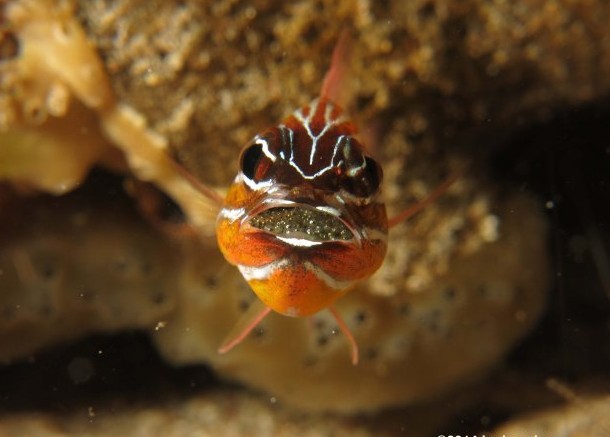
In her latest article for Scubaverse.com, Janice Nigro gets her Gangga Style on when she checks out the diving that Gangga Island has to offer…
Sometimes you wake up from a good dream in a place that seems like you are still in the dream. Today was one of those days. I woke up in my own bungalow on an island called Gangga in North Sulawesi, Indonesia.
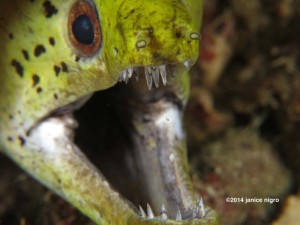 I am about two weeks into a so-called “swimabout”. No, I am not so clever to come up with this phrase myself. An acquaintance from a boat trip threw that term out there when I described the planned events for the next three months. It has been something I have thought about for the last seven years in Norway. Perhaps it is a way of resetting balance in the hours of sunlight in my life, so it is necessary.
I am about two weeks into a so-called “swimabout”. No, I am not so clever to come up with this phrase myself. An acquaintance from a boat trip threw that term out there when I described the planned events for the next three months. It has been something I have thought about for the last seven years in Norway. Perhaps it is a way of resetting balance in the hours of sunlight in my life, so it is necessary.
My trip started with a 50.6 second time to lift off in the new Airbus A380. Amazing after several years of thinking about the “swimabout” and several months of planning, it only took 50.6 seconds to start. Of course it took another 33 hours to reach my final destination of Sorong, Indonesia, which is so far to the east that the people no longer look Indonesian, but rather are Papuans.
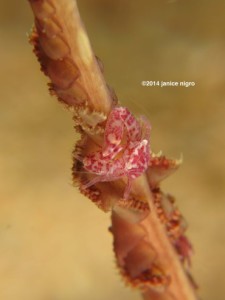 I traveled to Sorong to be on a liveaboard in Raja Ampat (another story) so to reach Gangga Island, I took an extremely long route. Gangga is another one of those places that doesn’t appear on most US travel itineraries, but it should. You can travel all the way here on Singapore Airlines and leave just as easily, which is important if you have ever traveled on domestic Indonesian flights. Since I had to fly from Sorong to Manado in North Sulawesi, I had two flights, one that stopped over in my favourite international airport, Makassar, which is always printed on your ticket as Ujung Pandang. Confusing. Even more confusing is that my flights were on two different airlines, which meant that I had to claim my baggage, recheck-in, and pay again for overweight baggage in Makassar. To give you an example of how much you have to just focus on the endpoint while traveling in Indonesia, in Sorong, I was allowed 20 kilos and was three kilos over at 2USD per kilo. In Makassar, I was only allowed 15 kilos but at the rate of 1.10USD per kilo. Essentially the same price. My bag made it, as did I to the international airport in Manado, and one thing I was glad to not have to do was fly Indonesian domestic flights further. They are jam packed with people and things…
I traveled to Sorong to be on a liveaboard in Raja Ampat (another story) so to reach Gangga Island, I took an extremely long route. Gangga is another one of those places that doesn’t appear on most US travel itineraries, but it should. You can travel all the way here on Singapore Airlines and leave just as easily, which is important if you have ever traveled on domestic Indonesian flights. Since I had to fly from Sorong to Manado in North Sulawesi, I had two flights, one that stopped over in my favourite international airport, Makassar, which is always printed on your ticket as Ujung Pandang. Confusing. Even more confusing is that my flights were on two different airlines, which meant that I had to claim my baggage, recheck-in, and pay again for overweight baggage in Makassar. To give you an example of how much you have to just focus on the endpoint while traveling in Indonesia, in Sorong, I was allowed 20 kilos and was three kilos over at 2USD per kilo. In Makassar, I was only allowed 15 kilos but at the rate of 1.10USD per kilo. Essentially the same price. My bag made it, as did I to the international airport in Manado, and one thing I was glad to not have to do was fly Indonesian domestic flights further. They are jam packed with people and things…
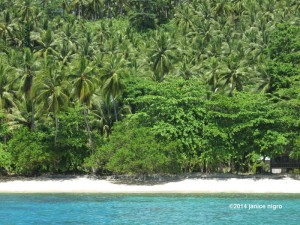 I landed in Manado, with my bag, to a place so green and packed with palm trees and rain and fresh water rivers. The driver from the resort found me immediately, and we drove off. It was about a 45-minute car ride to the sea where a boat picked me up and then another 30 minutes to Gangga Island.
I landed in Manado, with my bag, to a place so green and packed with palm trees and rain and fresh water rivers. The driver from the resort found me immediately, and we drove off. It was about a 45-minute car ride to the sea where a boat picked me up and then another 30 minutes to Gangga Island.
I could not find Gangga time on my iPhone, and if it existed, it would not be linked to GMT anyway. It is a safe place away from so-called civilization where the most you have to worry about are the falling coconuts and ants getting into your chocolate. Falling coconuts are a real hazard because the island is packed with coconut trees. In fact, one day about a meter in front of me a coconut dropped, bam, as if to awaken me suddenly from my dream.
Indonesians even on Gangga time still recognize different times of the day with different greetings in the same way that Italians do. In Italy, buon giorno is for good morning and at some point in the day before night but sometime after lunch it becomes buona sera. It is much the same in Indonesia, except that there are four greetings throughout the day. Like most languages there is good morning and good evening, but I have not quite mastered the transition between good afternoon, selamat siang, and good late afternoon, for lack of a better phrase, selamat sore. I am often missing that part of the day when the transition occurs anyway because I am, of course, usually under the water.
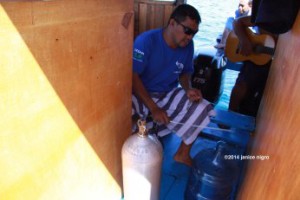 The second half of November seems to be a slow time for the Gangga Island Resort. So slow in fact that I have had my own personal dive guide, Paulus, for every dive, and I share a day boat with only six others who are all from German speaking countries. I have basically had a choice between speaking German or Indonesian. I took Indonesian. Two very different languages as one is grammar-rich and the other not, although word positions in Indonesian are backwards for native English speakers. It is all relative because if you would ask an Indonesian, he/she would say that English is backwards. After so many days, I can be at least polite and report my dive statistics in Indonesian.
The second half of November seems to be a slow time for the Gangga Island Resort. So slow in fact that I have had my own personal dive guide, Paulus, for every dive, and I share a day boat with only six others who are all from German speaking countries. I have basically had a choice between speaking German or Indonesian. I took Indonesian. Two very different languages as one is grammar-rich and the other not, although word positions in Indonesian are backwards for native English speakers. It is all relative because if you would ask an Indonesian, he/she would say that English is backwards. After so many days, I can be at least polite and report my dive statistics in Indonesian.
Since the dive sites from Gangga Island all have Indonesian names, I am every day learning a couple of new, useful words in Indonesian, such as gray and banana, and east and west. You can mix these words together to get different sites around Gangga and Bankga Island, which is also nearby. So an added plus to keeping the dive log is that some Indonesian words will creep into your vocabulary, and now I can discuss the colour of a banana.
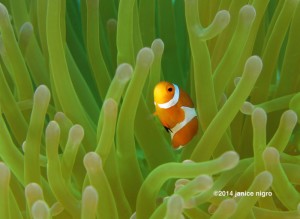 My guide Paulus is a local from an island nearby. It is a small village and his father fished (still fishes) every day to send his children all the way through university. It is somewhat humbling to meet such a person and to hear their life story-and in your own language of English. He has even built an artificial reef system with electricity running through it to stimulate hard coral growth. You can tell just by looking at the structures that he has a sense of humour. One of his additional talents is to play the guitar and sing. Not only does he play the guitar, but anything that will make a sound. So in between dives, we were treated to harmonies by the guys on the boat and they would take turns playing the guitar, accompanied by “drum beats” from the empty tanks, empty water carboys, or the boat. Wow, what a tough job interview is all I could think.
My guide Paulus is a local from an island nearby. It is a small village and his father fished (still fishes) every day to send his children all the way through university. It is somewhat humbling to meet such a person and to hear their life story-and in your own language of English. He has even built an artificial reef system with electricity running through it to stimulate hard coral growth. You can tell just by looking at the structures that he has a sense of humour. One of his additional talents is to play the guitar and sing. Not only does he play the guitar, but anything that will make a sound. So in between dives, we were treated to harmonies by the guys on the boat and they would take turns playing the guitar, accompanied by “drum beats” from the empty tanks, empty water carboys, or the boat. Wow, what a tough job interview is all I could think.
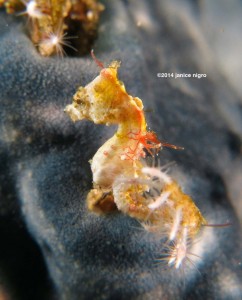 Paulus is a specialist it seems in finding really small critters everywhere. The type of creatures that you still need the dive guide when you look at your photos. I have seen Pontohi hippocampus (a type of pygmy seahorse that lives on the rocks) before but here I see one nearly every day. I am still not sure how he finds them because even when he shows it to me and I look away for a moment, I have lost it.
Paulus is a specialist it seems in finding really small critters everywhere. The type of creatures that you still need the dive guide when you look at your photos. I have seen Pontohi hippocampus (a type of pygmy seahorse that lives on the rocks) before but here I see one nearly every day. I am still not sure how he finds them because even when he shows it to me and I look away for a moment, I have lost it.
One of the most interesting parts of the dive sites around Gangga Island is the geography. The entire area has been more or less formed by lava. I don’t know how long ago it evolved as it has as there are currently no active volcanoes in the vicinity. The lava is sometimes big square blocks with beautiful soft corals growing out everywhere. On one dive, Sahaung Satu, the lava formed as a broad plateau or as the floor of a Greek temple, even with steps. You almost expect to see some fallen ancient statues. Instead, you will find a pile of baby white tip reef sharks. When I asked Paulus where the mother was, he told me, “At the supermarket. Why not?” Yes, probably, the white tip version.
One of my favourite creatures is the boxer crab. These crabs live under the coral rubble in a symbiotic relationship with two small anemones (OK, so there is that anemone theme/obsession again…). I have never witnessed a guide actually finding one so I can’t verify where they come from, but it is from somewhere under the rubble. There is a lot of rubble, so you can imagine that when they signal to me that they have found something and it’s a boxer crab, I am amazed. On an afternoon dive at Lakehe with no one else, I was treated to this small wonder of nature on a viewing all of my own.
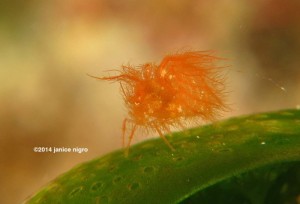 The wonders of nature get even smaller. Microscopic. One day I was looking at a tiny red fur ball at Air Benua (Benua water). I could see that the fur ball somehow motored around with purpose, but it was impossible to see which end was driving the maneuvers. I took a photo and only then could I see some eyes but at the wrong end of the photo. In the afternoon at Lihaga, I saw a green blob and again only after I looked at the photo could I see the eyes, some antennae, and legs of the hairy green shrimp. You begin to better appreciate how life develops. One egg, one sperm and you become either a hairy red shrimp or a whale shark.
The wonders of nature get even smaller. Microscopic. One day I was looking at a tiny red fur ball at Air Benua (Benua water). I could see that the fur ball somehow motored around with purpose, but it was impossible to see which end was driving the maneuvers. I took a photo and only then could I see some eyes but at the wrong end of the photo. In the afternoon at Lihaga, I saw a green blob and again only after I looked at the photo could I see the eyes, some antennae, and legs of the hairy green shrimp. You begin to better appreciate how life develops. One egg, one sperm and you become either a hairy red shrimp or a whale shark.
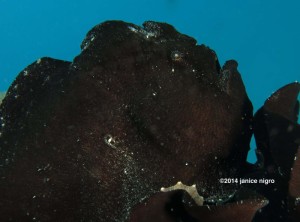 Just when you think you could be bored diving from a resort (not possible for me), they take you to a dive site like Efratha along Bangka Island. It is a sandy slope and a wall on one side of the island. Paulus loves to scan the sand for small creatures and easily coaxes mantis shrimp out of their holes. After an exhausting photo session over the sand, he brought me to a wall filled with cirque d’soleiling nudibranchs, a black Pontohi hippocampus that refused to look at me, and a giant black frogfish. At one point, he was pointing to a Halimeda ghost pipefish while looking for other creatures simultaneously.
Just when you think you could be bored diving from a resort (not possible for me), they take you to a dive site like Efratha along Bangka Island. It is a sandy slope and a wall on one side of the island. Paulus loves to scan the sand for small creatures and easily coaxes mantis shrimp out of their holes. After an exhausting photo session over the sand, he brought me to a wall filled with cirque d’soleiling nudibranchs, a black Pontohi hippocampus that refused to look at me, and a giant black frogfish. At one point, he was pointing to a Halimeda ghost pipefish while looking for other creatures simultaneously.
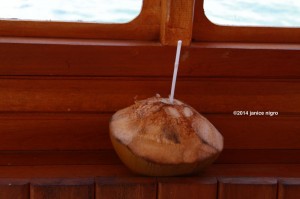 Although I have been keeping a dive log as usual while I am here, it really should be a food log. I have been eating a lot of fish, which perhaps is a conflict of interest, but here it is so fresh and well, they often serve it with coconut milk… Meals are actually four courses and since I have lost my chocolate to the ants, I am especially interested each evening in dessert. My favourite has been steamed banana with coconut milk. Sure, it almost sounds like the best thing you could get to eat if you have lost all of your teeth, but even if you have all of your teeth, you are anxiously waiting for it to reappear on the menu. Before I set off on this adventure, it seemed logical to think that I could become smaller on a small island diving three times a day. But after several days in Gangga, if there is Gangga time, I now believe in Gangga weight…
Although I have been keeping a dive log as usual while I am here, it really should be a food log. I have been eating a lot of fish, which perhaps is a conflict of interest, but here it is so fresh and well, they often serve it with coconut milk… Meals are actually four courses and since I have lost my chocolate to the ants, I am especially interested each evening in dessert. My favourite has been steamed banana with coconut milk. Sure, it almost sounds like the best thing you could get to eat if you have lost all of your teeth, but even if you have all of your teeth, you are anxiously waiting for it to reappear on the menu. Before I set off on this adventure, it seemed logical to think that I could become smaller on a small island diving three times a day. But after several days in Gangga, if there is Gangga time, I now believe in Gangga weight…
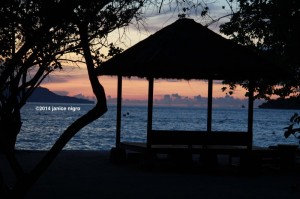 There doesn’t seem to be even enough Gangga time in the day to do everything that I “have” to do. Dive, eat, nap, and watch the sunset. My bungalow is right by the sea however, so you can multi-task, as a big window in the bathroom allows you to take a shower and peak out at the sunset simultaneously. And when you think that you have not paid enough reverence to nature throughout the day, you still have the stars to admire after dinner and sometimes the staff will sing. One night three of us watched for shooting stars and over the course of an hour, we saw five!
There doesn’t seem to be even enough Gangga time in the day to do everything that I “have” to do. Dive, eat, nap, and watch the sunset. My bungalow is right by the sea however, so you can multi-task, as a big window in the bathroom allows you to take a shower and peak out at the sunset simultaneously. And when you think that you have not paid enough reverence to nature throughout the day, you still have the stars to admire after dinner and sometimes the staff will sing. One night three of us watched for shooting stars and over the course of an hour, we saw five!
So now if you meet someone and they say they are from Gangga Island, you can say, yes, I know it.
Gear News
Scubapro Free Octopus Promotion 2024

Free Octopus with every purchase of a SCUBAPRO regulator system
Just in time for the spring season, divers can save money with the FREE OCTOPUS SPRING PROMOTION! Until July 31st SCUBAPRO offers an Octopus for free
with every purchase of a regulator system!
Get a free S270 OCTOPUS with purchase of these combinations:
MK25 EVO or MK19 EVO with A700
MK25 EVO or MK19 EVO with S620Ti
MK25 EVO or MK19 EVO with D420
MK25 EVO Din mit S620Ti-X
Get a free R105 OCTOPUS with purchase of the following combinations:
MK25 EVO or MK19 EVO with G260
MK25 EVO or MK17 EVO with S600
SCUBAPRO offers a 30-year first owner warranty on all regulators, with a revision period of two years or 100 dives. All SCUBAPRO regulators are of course certified according to the new European test standard EN250-2014.
Available at participating SCUBAPRO dealers. Promotion may not be available in all regions. Find an authorized SCUBAPRO Dealer at scubapro.com.
More information available on www.scubapro.com.
Blogs
Northern Red Sea Reefs and Wrecks Trip Report, Part 3: The Mighty Thistlegorm

Jake Davies boards Ghazala Explorer for an unforgettable Red Sea diving experience…
Overnight, the wind picked up, making the planned morning dive a bit bumpy on the Zodiacs to the drop point on Thomas Reef. There, we would dive along the reef before descending through the canyon and then passing under the arch before ascending the wall with a gentle drift. The site provided great encounters with more pelagic species, including shoals of large barracuda, tuna, and bigeye trevally.
Once back on the boat, it was time to get everything tied down again as we would head back south. This time, with the wind behind us, heading to Ras Mohammed to dive Jackfish Alley for another great gentle drift wall dive before then heading up the coast towards the Gulf of Suez to moor up at the wreck of the Thistlegorm. This being the highlight wreck dive of the trip and for many onboard, including myself, it was the first time diving this iconic wreck. I had heard so much about the wreck from friends, and globally, this is a must on any diver’s list. Fortunately for us, there was only one other boat at the site, which was a rarity. A great briefing was delivered by Ahmed, who provided a detailed background about the wreck’s history along with all the required safety information as the currents and visibility at the site can be variable.

Kitting up, there was a lot of excitement on deck before entering the water and heading down the shoreline. Descending to the wreck, there was a light northerly current which reduced the visibility, making it feel more like the conditions that can be found off the Welsh coast. At 10m from the bottom, the outline of the wreck appeared as we reached the area of the wreck which had been bombed, as our mooring line was attached to part of the propeller shaft. Arriving on deck, instantly everywhere you looked there were many of the supplies which the ship was carrying, including Bren Carrier tanks and projectiles that instantly stood out.

We headed around the exterior, taking a look at the large propeller and guns mounted on deck before entering the wreck on the port side to take a look in the holds. It was incredible to see all the trucks, Norton 16H, and BSA motorcycles still perfectly stacked within, providing a real snapshot in time.

Overall, we had four dives on the Thistlegorm, where for all of the dives we were the only group in the water, and at times, there were just three of us on the whole wreck, which made it even more special, especially knowing that most days the wreck has hundreds of divers. Along with the history of the wreck, there was plenty of marine life on the wreck and around, from big green turtles to batfish, along with shoals of mackerel being hunted by trevally. Some unforgettable dives.

The final leg of the trip saw us cross back over the Suez Canal to the Gobal Islands where we planned to stay the night and do three dives at the Dolphin House for the potential of sharing the dive with dolphins. The site, which included a channel that was teeming with reef fish, especially large numbers of goatfish that swam in large shoals along the edge of the reef. These were nice relaxing dives to end the week. Unfortunately, the dolphins didn’t show up, which was okay as like all marine life they are difficult to predict and you can’t guarantee what’s going to be seen. With the last dive complete, we headed back to port for the final night where it was time to clean all the kit and pack before the departure flight the next day.

The whole week from start to finish on Ghazala Explorer was amazing; the boat had all the facilities you need for a comfortable week aboard. The crew were always there to help throughout the day and the chefs providing top quality food which was required after every dive. The itinerary providing some of the best diving with a nice mixture of wreck and reef dives. I would recommend the trip to anyone, whether it’s your first Red Sea liveaboard in the Red Sea or you’re revisiting. Hopefully, it’s not too long before I head back to explore more of the Red Sea onboard Ghazala Explorer.

To find out more about the Northern Red Sea reef and wrecks itineraries aboard Ghazala Explorer, or to book, contact Scuba Travel now:
Email: dive@scubatravel.com
Tel: +44 (0)1483 411590
Photos: Jake Davies / Avalon.Red
-

 News3 months ago
News3 months agoHone your underwater photography skills with Alphamarine Photography at Red Sea Diving Safari in March
-

 News3 months ago
News3 months agoCapturing Critters in Lembeh Underwater Photography Workshop 2024: Event Roundup
-

 Marine Life & Conservation Blogs2 months ago
Marine Life & Conservation Blogs2 months agoCreature Feature: Swell Sharks
-

 Blogs2 months ago
Blogs2 months agoMurex Resorts: Passport to Paradise!
-

 Blogs2 months ago
Blogs2 months agoDiver Discovering Whale Skeletons Beneath Ice Judged World’s Best Underwater Photograph
-

 Marine Life & Conservation2 months ago
Marine Life & Conservation2 months agoSave the Manatee Club launches brand new webcams at Silver Springs State Park, Florida
-

 Gear Reviews3 months ago
Gear Reviews3 months agoGear Review: Oceanic+ Dive Housing for iPhone
-

 Gear Reviews2 weeks ago
Gear Reviews2 weeks agoGEAR REVIEW – Revolutionising Diving Comfort: The Sharkskin T2 Chillproof Suit
















